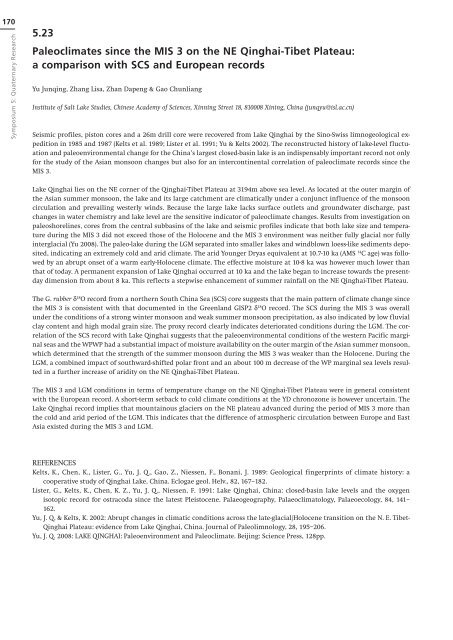Open Session - SWISS GEOSCIENCE MEETINGs
Open Session - SWISS GEOSCIENCE MEETINGs
Open Session - SWISS GEOSCIENCE MEETINGs
You also want an ePaper? Increase the reach of your titles
YUMPU automatically turns print PDFs into web optimized ePapers that Google loves.
1 0<br />
Symposium 5: Quaternary Research<br />
.23<br />
Paleoclimates since the MIS 3 on the NE Qinghai-Tibet Plateau:<br />
a comparison with SCS and European records<br />
Yu Junqing, Zhang Lisa, Zhan Dapeng & Gao Chunliang<br />
Institute of Salt Lake Studies, Chinese Academy of Sciences, Xinning Street 18, 810008 Xining, China (junqyu@isl.ac.cn)<br />
Seismic profiles, piston cores and a 26m drill core were recovered from Lake Qinghai by the Sino-Swiss limnogeological expedition<br />
in 1985 and 1987 (Kelts et al. 1989; Lister et al. 1991; Yu & Kelts 2002). The reconstructed history of lake-level fluctuation<br />
and paleoenvironmental change for the China’s largest closed-basin lake is an indispensably important record not only<br />
for the study of the Asian monsoon changes but also for an intercontinental correlation of paleoclimate records since the<br />
MIS 3.<br />
Lake Qinghai lies on the NE corner of the Qinghai-Tibet Plateau at 3194m above sea level. As located at the outer margin of<br />
the Asian summer monsoon, the lake and its large catchment are climatically under a conjunct influence of the monsoon<br />
circulation and prevailing westerly winds. Because the large lake lacks surface outlets and groundwater discharge, past<br />
changes in water chemistry and lake level are the sensitive indicator of paleoclimate changes. Results from investigation on<br />
paleoshorelines, cores from the central subbasins of the lake and seismic profiles indicate that both lake size and temperature<br />
during the MIS 3 did not exceed those of the Holocene and the MIS 3 environment was neither fully glacial nor fully<br />
interglacial (Yu 2008). The paleo-lake during the LGM separated into smaller lakes and windblown loess-like sediments deposited,<br />
indicating an extremely cold and arid climate. The arid Younger Dryas equivalent at 10.7-10 ka (AMS 14 C age) was followed<br />
by an abrupt onset of a warm early-Holocene climate. The effective moisture at 10-8 ka was however much lower than<br />
that of today. A permanent expansion of Lake Qinghai occurred at 10 ka and the lake began to increase towards the presentday<br />
dimension from about 8 ka. This reflects a stepwise enhancement of summer rainfall on the NE Qinghai-Tibet Plateau.<br />
The G. rubber δ 18 O record from a northern South China Sea (SCS) core suggests that the main pattern of climate change since<br />
the MIS 3 is consistent with that documented in the Greenland GISP2 δ 18 O record. The SCS during the MIS 3 was overall<br />
under the conditions of a strong winter monsoon and weak summer monsoon precipitation, as also indicated by low fluvial<br />
clay content and high modal grain size. The proxy record clearly indicates deteriorated conditions during the LGM. The correlation<br />
of the SCS record with Lake Qinghai suggests that the paleoenvironmental conditions of the western Pacific marginal<br />
seas and the WPWP had a substantial impact of moisture availability on the outer margin of the Asian summer monsoon,<br />
which determined that the strength of the summer monsoon during the MIS 3 was weaker than the Holocene. During the<br />
LGM, a combined impact of southward-shifted polar front and an about 100 m decrease of the WP marginal sea levels resulted<br />
in a further increase of aridity on the NE Qinghai-Tibet Plateau.<br />
The MIS 3 and LGM conditions in terms of temperature change on the NE Qinghai-Tibet Plateau were in general consistent<br />
with the European record. A short-term setback to cold climate conditions at the YD chronozone is however uncertain. The<br />
Lake Qinghai record implies that mountainous glaciers on the NE plateau advanced during the period of MIS 3 more than<br />
the cold and arid period of the LGM. This indicates that the difference of atmospheric circulation between Europe and East<br />
Asia existed during the MIS 3 and LGM.<br />
REFERENCES<br />
Kelts, K., Chen, K., Lister, G., Yu, J. Q., Gao, Z., Niessen, F., Bonani, J. 1989: Geological fingerprints of climate history: a<br />
cooperative study of Qinghai Lake, China. Eclogae geol. Helv., 82, 167–182.<br />
Lister, G., Kelts, K., Chen, K. Z., Yu, J. Q., Niessen, F. 1991: Lake Qinghai, China: closed-basin lake levels and the oxygen<br />
isotopic record for ostracoda since the latest Pleistocene. Palaeogeography, Palaeoclimatology, Palaeoecology, 84, 141–<br />
162.<br />
Yu, J. Q. & Kelts, K. 2002: Abrupt changes in climatic conditions across the late-glacial/Holocene transition on the N. E. Tibet-<br />
Qinghai Plateau: evidence from Lake Qinghai, China. Journal of Paleolimnology, 28, 195–206.<br />
Yu, J. Q. 2008: LAKE QINGHAI: Paleoenvironment and Paleoclimate. Beijing: Science Press, 128pp.









